In 1974, as Dallas/Fort Worth Airport opened to serve as the main regional airport and airlines moved their flights across town to the new facility, apart from one. Southwest AIrlines decided that their home at Love Field was the best way to service their customers, and from that moment on, the history of the airport would be tumultuous.
In 1979, the Wright Amendment, named after Fort Worth Congressman Jim Wright, set about restricting the airport to certain limitations. As the years went on, the amendment has had a number of changes, easing some of the restrictions.
The Wright Amendment originally restricted airlines with aircraft of greater than 56 seats to only fly services within Texas, or to the four neighboring states of New Mexico, Louisiana, Arkansas, and Oklahoma. Southwest expanded their services out to those states, but the amendment was a severe restriction on their ability to really become the airline that they wanted.
As the years went on, further changes were made, adding Alabama, Kansas, Mississippi, and eventually Missouri to the state list. The biggest changes came in 2006 though, when the repeal of the Wright Amendment began. Although the original changes in 2006 would allow through-ticketing (previously, if you wanted to fly say Dallas to Denver, you would need to have two separate tickets, one to get you to an intermediary city like Albuquerque or Kansas City, the other onto Denver). Eventually, in 2014, the 2006 amendment/repeal would allow long-haul flights directly out of Dallas Love Field.
When the distance restrictions on Love Field will lift on October 13th, 2014, the airport needed to be ready and modernize. Renovations were started in 2009 to bring the airport to a whole new level, one that I got to experience on my recent trip to Dallas.
The airport’s new concourse was opened earlier this year, with the last piece of the puzzle being the baggage claim area that opened in late September, right in time for the big day in October.
When you step through one of the 20 gates at the airport you walk in to an extremely modern facility. The airport looks spectacular – all around you can find high-resolution Flight Information Display Screens (FIDS).
The majority of the gate areas are set up in the Southwest fashion, with a shared customer service desk between a few gates and individual boarding lines and podiums at each.
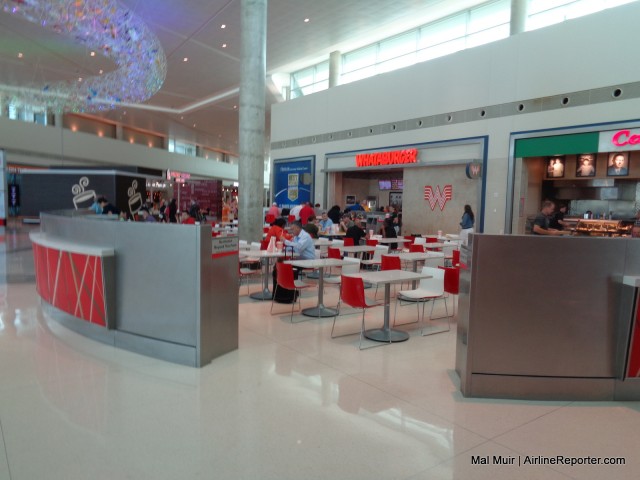
Part of the Love Field food court area. Local favorites on offer here with Whataburger, a popular burger chain in Texas.
The main thing that strikes your eye as you walk through is the quality of the facilities. All-new food and shopping outlets line the main terminal. A lot of local options are present, with fast-casual food like Whataburger or Dickey’s Barbeque. This gives the terminal a more local feel, where Texans know they can get a good taste of home, or tourists can know they are getting something the locals would eat (apparently Whataburger is quite good, though I never tried it).
Walking through the food court area (if you could call it that) there is a large art piece hanging from the ceiling. What caught my eye with this piece is that inside the actual structure you could see cutouts of aircraft and other travel related items — awesome!
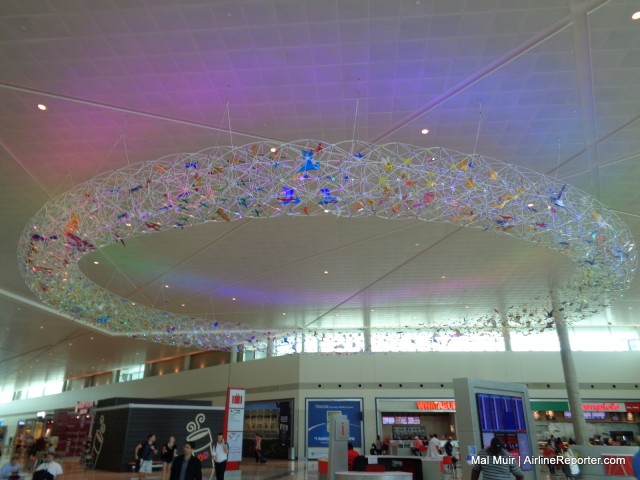
Very nice artwork hanging from the ceiling at Love Field. Inside the art is different shaped and colored items; I saw a few planes in there!
As you exit the airside area, the first thing you see is a Dunkin Donuts. This seems to me like a great idea, as all passengers leaving the terminal come out through this one choke point. This gives friends and family somewhere to wait for their loved ones as they come off their flight.
As you come down the escalators to the ground floor, this is where the ticketing desks, check-in areas, security, and baggage claim are located. All have been refurbished and the security area, in particular, is large and has plenty of lanes, giving you the ability to pass through quickly, even without status or pre check.
The new baggage areas was the last part of the refurbishment to open and it looks great. Compared to the older temporary facility that I saw when I passed through, the new area is spacious, large, and has a unique look to it.
All the new facilities at the airport mean that when the Wright Amendment restrictions end on October 13th, this facility will be world-class, ready to usher in a new era of flying to Dallas.
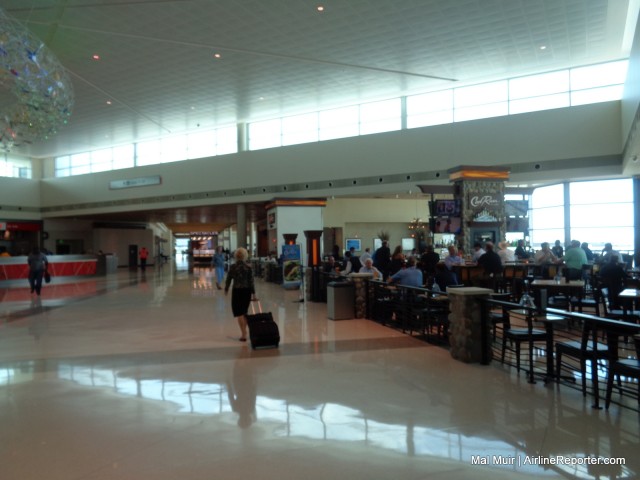
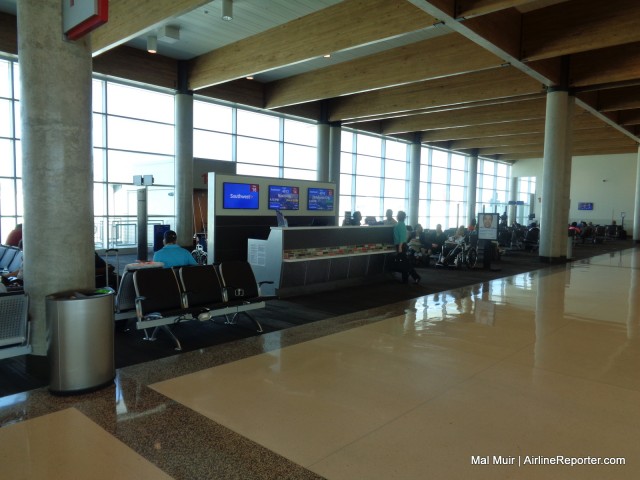
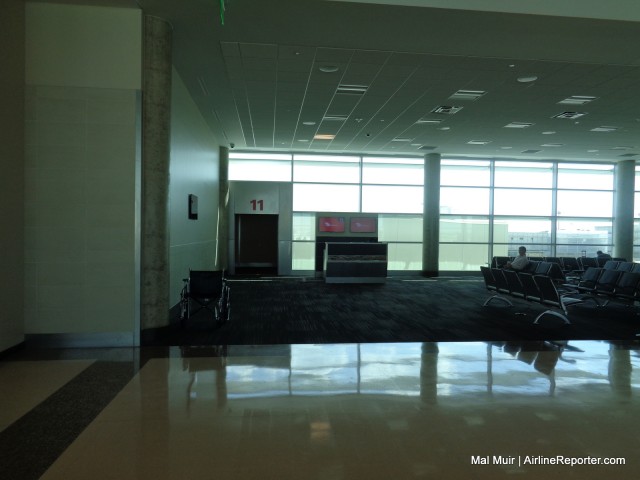
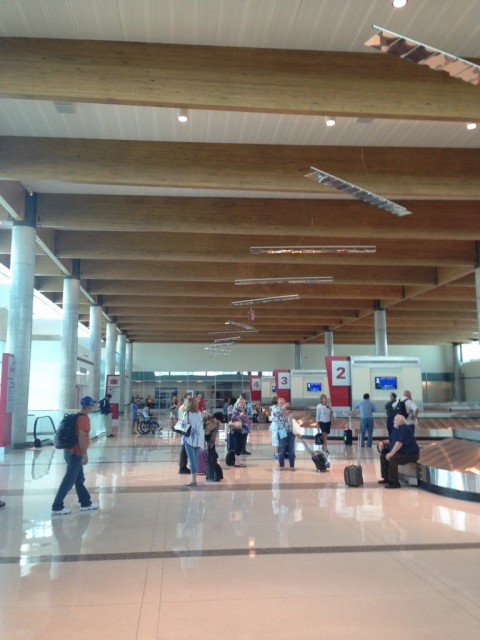
Oh yes. The Wright Amendment has been around for a long time and only this year (’14) finally expired. The W.A. stands as a near classical example of Bad Law, created for Bad Purposes and by people who have agendas somewhat different from open competition and whatever may be in the best interests of the flying general public. What a horrible excuse for laws, regulations and policies, “In the public interest.” IMO, the only reasonable approach is open, public slot and gate auctions – all of which include the ‘use it or lose it’ clause. Why not?
International access and the Open Skies (did I spell that right?) treaty agreements require a far different analysis. I’m also firmly in favor of Open Skies in most situations. Why? If noting else, open access to foreign-flag carriers flying between U.S. and foreign ports *may* stimulate our Big Three to improve their services (hard and soft) and finally force them to compete on price. IMO, our own carrier can compete, but with historical protections they have never learned how to compete. And – of course… If DOT or Treasury can substantiate inappropriate home government support for the foreign carriers, their operations can easily be limited. Still, the foreign carriers may NOT provide carriage between U.S. domestic ports,m as it should be. In most cases, U.S. carriers providing service between two foreign ports do well and do not disrupt the more regional operations; their primary interest is providing seamless links to their own long-haul services. Where the U.S. carrier lack is in the long haul, x-pond crossings. Sorry folks, but the Big Three just do not offer an equal or better service from outside the USA to inside – or in the reverse. A handful of very smart, service-oriented foreign flag carriers simply do it better, even in the cattle class cabin.
Of note: All carriers flying to/from the U.S. are subject to FAA Safety Rules and Procedures. Violators get banned, often quickly. Those who remain DO, IMO, operate safe airlines and fully equal to U.S. standards. This is NOT about safety. It is about customer service and – at the end of the day, price, regardless of cabin or class purchased. Our own carriers too often do not compete for important routes and we wonder why. IMO, our own carriers do not compete in these markets because they don’t know how. At times it is as simple as a pleasant attitude from cabin staff, too senior to care, vs. the others who approach the subject with smiles and a “Can Do” attitude. For a 12 – 14 hour flight (front cabin – or the tail end) which option would attract YOUR airfare dollars? Our carriers have plenty of access rights, but they do not use much of what they have. Why?
Let’s clarify one thing. The Wright Amendment lives on, in that the airport is artificially capped at 20 gates. The restrictions will still act to stifle competition and keep fares artificially high.
@John G. An excellent point! I had overlooked the gate count, growth potential and the often ‘unusual’ practices followed in Texas. While a truly wonderful state in so many respects, those Texans are often hostile toward outside business -and great caution is advised for anyone foolish enough to assume that Texas embraces the 21st century social norms accepted by most of the other 49 states. Texas welcomes visitors with deep pockets, but they still have zero interest in taking a fresh look at the range of social engagement issues. Texans may have implemented the requirements of the 50-year old school access and non-discrimination laws, but does not mean that they like them or endorse them. Outsiders hoping to soften a Texan’s view, or modify their reaction to an event, have another guess coming. For better or probably for worse, their values and practices are held close, compromise or are words foreign to them and their deafness can be profound. As one but so many issues pending, Texas must now confront – wait, hole your breathe…. Gay Marriage. I KNOW that they do not like it!! Still, ,dealing with it on their own has got to be far better politics than is having it jammed down their throats. They learned that protections like the Wright Amendment can have two edges – as can other issues. They are smart folks and they will adapt in time. Love Field needs to grow and to be free of single-purpose restrictions. Wright is gone, the protectionist amendment is gone (*almost,* as John notes. and Texas will thrive, if they open the ears, eyes and brains – just a little… Again, a great original post, Mal and keep them coming. -C.
DAL in its heyday – in the final years leading up to 1974 – was quite impressive and busy! Braniff, American and Delta had major hubs. I flew through DAL several times; including on Delta 741s! DAL had several concourses. I did an unsuccessful Search for the total number of gates but I guesstimate at LEAST 60 – likely several more!! Imagine if more of those gates had been allocated for Southwest after Jan 1974! Politicians had NO BUSINESS restricting Southwest as they did!
It wasnt about outsiders or non Texans, nor was it ever about restricting Southwest. It has always been a fight between the cities of Dallas and Fort Worth, with Fort Worth trying to force all air service to one shared airport so they can share in the profits equally.
@Cook – When discussing gay marriage, part of your commentary included the phrase “hole your breathe” which I’m assuming you meant “hold your breath” – Hm-m-m, Freudian slip there, Cookie?